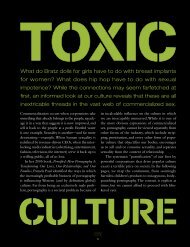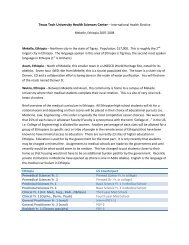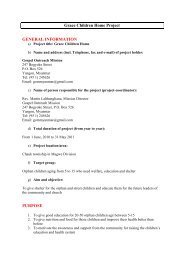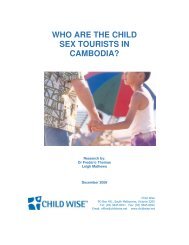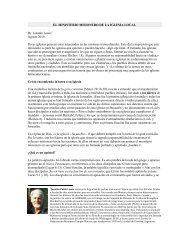Infectious Disease in Ethiopia - An Overview.pdf - World Wide Open
Infectious Disease in Ethiopia - An Overview.pdf - World Wide Open
Infectious Disease in Ethiopia - An Overview.pdf - World Wide Open
You also want an ePaper? Increase the reach of your titles
YUMPU automatically turns print PDFs into web optimized ePapers that Google loves.
<strong>Disease</strong>s<br />
Richard M. Hodes, MD<br />
<strong>Ethiopia</strong> encompasses a variety of geographic and climatic<br />
zones, with a wide range of disease. Average male lifespan<br />
is 41.4 years, female is 43.1 years. The death rate <strong>in</strong> the<br />
first year of life is 112.9/1000, from 0-5 years it is<br />
187.8/1000. Full immunization rates are 14.4%.<br />
Diarrhea (Tokumat) is responsible for nearly half of all<br />
deaths by age 5. The overall rate of diarrhea <strong>in</strong> the 2 weeks<br />
before the 2000 Demographic and Health Survey (DHS) of<br />
15,716 women and 2771 men was 23.6% (range: 12.2% <strong>in</strong> Addis<br />
Ababa to 19.3% <strong>in</strong> the Amhara region, 25% <strong>in</strong> the Oromiya, and<br />
29.4% <strong>in</strong> SNNP). Nearly 66% of mothers knew about packets of<br />
oral rehydration salts. 13.3% of children were brought to a<br />
health provider, 44.9% got <strong>in</strong>crease <strong>in</strong> fluids, oral<br />
rehydration salts, or homemade rehydration fluid.<br />
Diarrhea is believed caused by the will of God. A survey of<br />
over 500 mothers <strong>in</strong> 3 Gondar villages found that 84.5%<br />
believed that milk teeth extraction is useful <strong>in</strong> the<br />
treatment of diarrhea. 70% of children surveyed had<br />
undergone this procedure.<br />
Hepatitis (YeWof Beshita, lit: “the bird disease”) is very<br />
common. About 100% have antibiotics to hepatitis A<br />
(transmitted by fecal-oral route) by age 15. Approximately<br />
10-13% are carriers of the hepatitis B surface antigen. This<br />
is felt to be due to locally acquired transmission, and not<br />
mother-to-child transmission. Hepatitis is believed caused<br />
by a bat or bird fly<strong>in</strong>g overhead.<br />
Intest<strong>in</strong>al parasites account for 8.5% of male and 10.4% of<br />
female visits to OPDs. Prevalence rates of 19% have been<br />
reported for ameba, 11% for giardia. <strong>Ethiopia</strong>ns often<br />
acquire Taenia sag<strong>in</strong>ata from eat<strong>in</strong>g raw beef. They treat<br />
themselves with about a dozen traditional remedies,<br />
especially kosso (Hagenia abyss<strong>in</strong>ica). Roundworm (Ascaris<br />
lumbracoides) rates <strong>in</strong>crease with altitude, with 59% <strong>in</strong><br />
altitudes >2500 meters. Hookworm (especially Necator<br />
americanus) rates peak at nearly 29% <strong>in</strong> the 800-1200<br />
altitude range.<br />
It is estimated that 20% of <strong>Ethiopia</strong>ns are affected by<br />
Schistosomiasis mansoni. Most of the endemic communities are<br />
<strong>in</strong> villages and small towns by rivers and streams at
<strong>in</strong>termediate altitudes between 1300 and 2000 meters,<br />
especially the Lake Tana bas<strong>in</strong>. Biomphalaria pfeifferi is<br />
the most common snail host. In contrast, S. hematobium is<br />
found below 800 meters <strong>in</strong> the Awash valley, the lower Wabe<br />
Shebele Valley, and among the Sudan border <strong>in</strong> Wellega.<br />
The rate of bl<strong>in</strong>dness is 1.5%; 80% due to preventable or<br />
curable diseases. About 40% of bl<strong>in</strong>dness is due to trachoma.<br />
Leprosy (yisiga deway) rates decl<strong>in</strong>ed from 26/1000 <strong>in</strong> 1982<br />
to .7/1000 <strong>in</strong> 1990.<br />
TB: (sanba nikersa) The 1988-1990 Tuberculosis survey found<br />
that there was a 1.4% annual risk of <strong>in</strong>fection. It is likely<br />
that this has <strong>in</strong>creased <strong>in</strong> recent years due to the<br />
prevalence of HIV.<br />
<strong>Ethiopia</strong> is located at the eastern end of the African<br />
men<strong>in</strong>gitis belt. Epidemics of men<strong>in</strong>gococcus (N.<br />
men<strong>in</strong>gitidis, group A) occur every 8-10 years. The last<br />
epidemic was <strong>in</strong> 2000.<br />
Sexually transmitted diseases rank 6 th out of 15 reported<br />
disease groups. Gonorrhea (chebt) is most common, often<br />
attributed to ur<strong>in</strong>at<strong>in</strong>g under a full moon.<br />
Malaria: (woba beshita) About 3/4 of the country is thought<br />
to have malaria, <strong>in</strong> areas below 2000 meters. It is<br />
especially found <strong>in</strong> Humera, Metema, Metekel, Bambel, Gode,<br />
and the Awash Valley. Cases peak after cessation of the<br />
ra<strong>in</strong>s, both <strong>in</strong> September and <strong>in</strong> April. <strong>An</strong>opheles gambiae is<br />
the most common vector <strong>in</strong> <strong>Ethiopia</strong>. It is estimated that P.<br />
falciparum causes 60% of cases, with most of the rema<strong>in</strong>der<br />
caused by P. vivax. It is believed to a variety of causes,<br />
especially sleep<strong>in</strong>g <strong>in</strong> an arid area.<br />
AIDS: UNAIDS estimates that 3 million <strong>Ethiopia</strong>ns are<br />
<strong>in</strong>fected with the HIV virus, an adult rate of 10.6%. This<br />
rate is #16 <strong>in</strong> the world, but the number is #3 <strong>in</strong> the world<br />
after S. Africa and India. 1/11 of all HIV+ people <strong>in</strong> the<br />
world reside <strong>in</strong> <strong>Ethiopia</strong>. AIDS is primarily transmitted<br />
through heterosexual relations. 42% of hospital beds are<br />
taken by AIDS patients, and 1.2 million have been orphaned.<br />
The DHS found that 34% of women and 60% of men knew that<br />
condom use could prevent HIV. 32% of women and 8% of men<br />
knew no way of prevent<strong>in</strong>g HIV. 30.3%% of men and 13.4% of
women used a condom <strong>in</strong> their last <strong>in</strong>tercourse with a noncohabit<strong>in</strong>g<br />
partner.<br />
Rheumatic Heart <strong>Disease</strong> due to consequences of rheumatic<br />
fever is the most common form of heart disease <strong>in</strong> young<br />
people and adults. Myocardial <strong>in</strong>farction is becom<strong>in</strong>g more<br />
common, with several admissions per week at Black Lion<br />
Hospital.<br />
Unique diseases and conditions to <strong>Ethiopia</strong> <strong>in</strong>clude:<br />
Relaps<strong>in</strong>g fever, caused by Borrelia recurrentis and<br />
transmitted by lice, is highly endemic <strong>in</strong> <strong>Ethiopia</strong>. It is<br />
likely that there are at least 10,000 cases annually, more<br />
than any other country. It tends to be found <strong>in</strong> the<br />
highlands from August-December.<br />
Neurolathyrism, spastic paraparesis caused by a neurotox<strong>in</strong><br />
<strong>in</strong> a grass pea, (lathyrus sativus), commonly known as guaya.<br />
It is found Epidemics have been reported dur<strong>in</strong>g fam<strong>in</strong>e<br />
times. In the Gondar area of Lake Tana, rates up to 3% have<br />
been reported from certa<strong>in</strong> villages, with an overall rate as<br />
1.7/100,000. This is also seen <strong>in</strong> India and Bangladesh.<br />
Podoconiosis, non-filarial elephantiasis, is found <strong>in</strong><br />
highland areas with underly<strong>in</strong>g basalt rock. A survey of<br />
250,000 people <strong>in</strong> the fertile highlands showed that<br />
27.2/1000 over age 15 were affected. It is possible that<br />
over 500,000 <strong>Ethiopia</strong>ns are affected. This is related to<br />
farm<strong>in</strong>g while barefoot. Ultra-f<strong>in</strong>e particles of alum<strong>in</strong>um<br />
silicate <strong>in</strong> the clay soil enters the sk<strong>in</strong>, along with<br />
silica, alum<strong>in</strong>a, and iron. There is no treatment, but the<br />
use of footwear is thought to be protective.<br />
Fistula: The rate of fistula, a consequence of obstructed<br />
labor, <strong>in</strong> <strong>Ethiopia</strong> is 55/100,000 births, believed to be the<br />
highest <strong>in</strong> the world. The Fistula Hospital <strong>in</strong> Addis Ababa<br />
operates on over 1000 cases/ year.<br />
Epidemic fluorosis is common <strong>in</strong> the <strong>Ethiopia</strong>n rift system,<br />
<strong>in</strong>clud<strong>in</strong>g the <strong>Ethiopia</strong>n rift valley. 64% of people liv<strong>in</strong>g <strong>in</strong><br />
Wonji for over 20 years had physical impairments consistent<br />
with this, <strong>in</strong>clud<strong>in</strong>g myelopathy and radiculopathy due to<br />
excess fluoride <strong>in</strong> the water.<br />
21 types of traditional healers have been reported <strong>in</strong><br />
<strong>Ethiopia</strong>. Common traditional practices <strong>in</strong>clude uvulectomy
(to prevent suffocation which would occur when the baby has<br />
a sore throat), eyelid <strong>in</strong>cision for prevention or treatment<br />
of eye disease, tooth extraction known as geg for diarrhea<br />
(especially lower <strong>in</strong>cisors), female circumcision (DHS<br />
prevalence rates of 79.9%, with 59.7% of women support<strong>in</strong>g<br />
the practice). Traditional diseases <strong>in</strong>clude zar (spirit<br />
posession), moynbagegn (headache with neurologic symptoms,<br />
and attent hono kere (permanent pregnancy which has turned<br />
to bone).<br />
Bibliography:<br />
Central Statistical Authority: Report on the 1998 health and<br />
nutrition survey, Addis Ababa, 1999. Dagnew MB, and Damena<br />
M. Traditional child health practices <strong>in</strong> communities <strong>in</strong><br />
northwest <strong>Ethiopia</strong>. Trop Doctor 20:40-41,1990. <strong>Ethiopia</strong><br />
Demographic and Health Survey 2000. Central Statistical<br />
Authority, Addis Ababa and ORC Macro, Calverton, MD. 5/2001.<br />
<strong>Ethiopia</strong>n M<strong>in</strong>istry of Health. AIDS <strong>in</strong> <strong>Ethiopia</strong>, 3 rd edition,<br />
Addis Ababa, 11/2000. Hodes RM. Pattern of heart disease <strong>in</strong><br />
<strong>Ethiopia</strong> as seen <strong>in</strong> a cardiology referral cl<strong>in</strong>ic. Cardiology<br />
(Basel) 1988;75:458-64. Hodes RM, Kloos H. Health and<br />
medical care <strong>in</strong> <strong>Ethiopia</strong>. New England Journal of Medic<strong>in</strong>e<br />
1988;319:918-924. Hodes RM, Seyoum B. The pattern of<br />
tuberculosis <strong>in</strong> Addis Ababa, <strong>Ethiopia</strong>. East African Medical<br />
Journal 1989;66:812-818. Hodes RM, Teferedegne B.<br />
Traditional beliefs and disease practices of <strong>Ethiopia</strong>n Jews.<br />
Israel J Med Sciences1996; 32:561-67. Hodes RM. Crosscultural<br />
medic<strong>in</strong>e and diverse health beliefs - <strong>Ethiopia</strong>ns<br />
abroad. Western Journal of Medic<strong>in</strong>e 1997;166:29-36. Kloos<br />
H, Ahmed Ze<strong>in</strong> Z: The ecology of health and disease <strong>in</strong><br />
<strong>Ethiopia</strong>, 2 nd edition. Westview Press, Boulder, 1993.<br />
Rubenste<strong>in</strong> A (ed): Medical and epidemiological aspectes of<br />
the <strong>Ethiopia</strong>n immigration to Israel Israel J Med Sci 1991;<br />
27(5):241-299. Rubenste<strong>in</strong> A (ed): The <strong>Ethiopia</strong>n immigration<br />
to Israel – Medical, epidemiological and health aspects.<br />
Israel J Med Sci 1993; 29 (6-7): 331-42.




